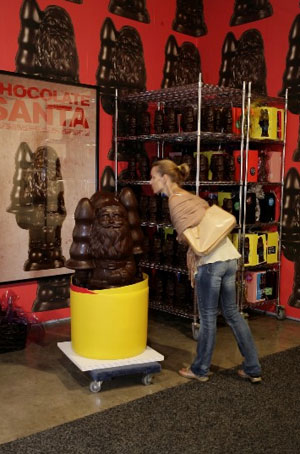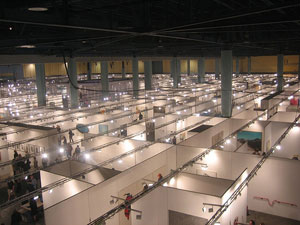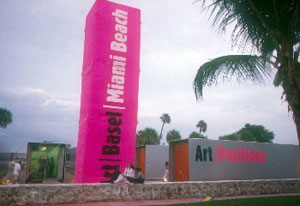
How festive! A chocolate Santa avec butt plug...by Paul McCarthy at the Maccarone Gallery booth...Courtesy MCH Swiss Exhibition (Basel/Zurich) AG
The air surrounding Maccarone Gallery booth at Art Basel Miami Beach is heavy with the smell of chocolate. Look! Chocolate holiday Santas…clasping…butt plugs? Paul McCarthy’s Santa with Butt Plug by Peter Paul Chocolates is a smaller, more affordable version of the artist’s full-scale sculpture displayed in front of the Basel fair in Switzerland this past summer, and at a hundred bucks a pop, they’re flying off the shelves. I decide against acquiring one as a holiday treat for the family, though—Grandma and Grandpa might not appreciate the irony.
While there is a huge range of art on view at Art Basel Miami, it all seems to send one message—SEX SELLS. There are stands that I’d be embarrassed to enter with my own mother, like, say, the one hung salon style with pictures of women masturbating. The fairs are literally filled with porn, porn and more porn. Sure, it’s art, but things have gotten a lot more explicit since Manet’s Le Dejeuner sur l’Herbe. The curtained art videos with warning notes are usually the really juicy ones.
The world’s biggest art collectors gather on the first Wednesday in December for the Art Basel Miami vernissage. The opening day starts at noon. It’s an exclusive chance for collectors to get first crack at the art. But the catch is you have to have a VIP card, and you only get one of those if you are big name collector-or dropped a lot of cash at last year’s fair. It’s also the best day for celebrity sightings—hello, Steve Martin! He may have a fab collection, but leave the guy alone, his hat and sunglasses mean he’s just here to buy. Unfortunately, his voice is a dead give away.
As evening sets in, a party unfolds in the Art Basel VIP lounge—but it’s always a scene unto itself. Every day various fair sponsors showcase their wares and services from assorted booths. Wanna buy a jet? How about some Cartier jewels? Sotheby’s is on hand to advise you on new purchases and to help you make way for them, in case you feel like unloading some old art. Of course there’s food and drink as well but VIP loungers are also offered the fair’s hottest commodity—a place sit down, which can be harder to find at the fair than in the middle of Tokyo.
An Art Basel VIP card will also get you all kinds of preferential treatment, including free admission to all of the other fairs and invites to private events at collectors’ extravagant homes. This is your chance to view over-the-top Miami mansions with thousands of square feet devoted to video installations.
The annual Art Basel Miami shindig encompasses more fairs than can be counted on all of your fingers and toes. And behind all of the expensive art and the jet set social scene are a lot of smoke and mirror tricks. Potemkin galleries arise as tents are erected on empty lots, shipping containers appear on the beach, warehouses adjacent to homeless shelters become glossy display areas and hotel rooms are pressed into service.
When you have this kind of widespread and makeshift transformation, problems abound. During a storm a couple of years ago, the first tents to pop up took on water during installation, and the convention center itself sprouted leaks. Imagine a $3.4 million Chagall hanging in a leaking building. Now think about a tent. Thank god the fair management had the good sense not turn on the lights and electrocute everyone. On the bright side, the flooding resulted in amazing displays of camaraderie. It was so bad that no one could bitch, all they could do was help their neighbors move to dry ground. People who had started unpacking crates and leaning work against the wall had to scramble as the water rose and created ponds on the uneven tent floors.
Technical problems are also rife at the fairs. This year was the first that Art Miami joined the December time slot as opposed to their usual January spot at the convention center, settling instead for a tent on an empty lot. While the tent boasted 12-foot walls, its aisles were wide and empty. Wide is good but empty is not when you can see the dealers cranking their necks to see famous Miami collector, Marty Margulies in someone else’s booth. But the move seemed to produce more than just attendance problems—on the opening evening, lights started going out, leaving scrambling technicians and pissed off dealers in the dark. It’s surprisingly hard to sell art if no one can see it…
Logistical problems abound at the fairs. Transporting all of that art is a nightmare of epic proportions; it’s like moving in an entire city for a week and then moving it out. It’s also a real schlep for the individual dealers, and there’s plenty of room for human error. Usually, galleries have specially fabricated crates for art and use professional art handlers to pick up, deliver and install the work. However, once they get to a fair, a gallery is not unlike any other small business with a lot of DIY going on. U-Haul trucks driven cross-country by exhausted dealers jam up traffic in front of the hotel fairs.
Most fair dealers have to be scrappy, using FedEx and other common carriers as shippers. Those swamped, one-man delivery “teams” skip the white glove treatment and simply toss pricey and fragile art off the truck. Really fragile and/or heavy stuff gets packed in crates and is sometimes send by common carrier. You can see dealers bitching at the cute sweaty guy driving the forklift to “Be careful!” before he accidentally rams the lift blades into the side of the crate. Some drivers dispense with the forklift. I have seen them actually roll “THIS SIDE UP” crates off the lift gate of a truck.
And then there are the unlucky dealers who may not get any art at all, damaged or otherwise. There is always some foreign dealer whose work is stuck in customs. In another surprising display of camaraderie, other dealers will sometimes offer them some of their extra inventory and work out a deal. This is much more likely with mid-level galleries (the less money involved, the nicer people are).
But how do you transport the massive influx of art buyers to 20-plus venues? The well-heeled have a car and driver while everyone else fights for taxis, shuttle buses and third world rickshaw bicycles. If you don’t have a personal driver or a decent budget for transportation ($25 and up from Wynwood to South Beach) the shuttle buses are your best bet—if you have the patience. Do your homework before you go if you are counting twenties. And don’t even think about a rental car; parking in South Beach is scarce and expensive. As a matter of fact, everything is scarce except art. Every hardware store and Walgreen’s anywhere near the fair sells out of light bulbs, push pins, packing tape and just about everything else as desperate gallerists descend like a plague of locusts.
The Wynwood Art District, now home to fairs like Aqua, Art Miami, NADA, PULSE and SCOPE, was first dominated by Miami collectors who housed their collections in warehouses. Margulies and the Rubells keep their warehouse collections open, with public and private hours during the fairs. New galleries have also opened in the past five years of Art Basel Miami. The area continues to be shared by Miami’s homeless population—you have guys with their own bedrolls being stepped over by ladies in Manolos. Some of them seek temporary employment with the fairs, but most continue with their “naps,” unaware of potential impalement by stiletto.
Art Basel, this European invader, has transformed the Miami art economy and caused dozens of parasite (euphemistically referred to as satellite or parallel fairs) to pop up everywhere from South Beach to the Wynwood Art District. Art Basel has also supplanted the NYC spring fairs as well as fairs in Chicago and San Francisco as the leading fair in the States.
Here’s the lowdown on some of the leading parasite, er parallel fairs:
Aqua Art Miami
Aqua is a hotel fair that grew up but kept its charming hotel location. This year, they expanded beyond their namesake hotel in South Beach by renting a warehouse with a labyrinth like floor plan (all they needed was a minotaur in the center). The organizers of this fair hail from the Pacific Northwest, but have branched out with more emerging and mid-level galleries from far and wide, including some Texans.
NADA (New Art Dealers Alliance)
Why a group of New York dealers started a fair in Miami called NADA is a question worth asking. The following statement is from the “About Us” section of the NADA website: "We believe that the adversarial approach to exhibiting and selling art has run its course.” If you look at the list of dealers, be assured they are some of them are the most adversarial dealers out there. Ironically NADA is a non-profit organization…
PULSE Contemporary Art Fair
Will Ramsey, the British founder of the Pulse Contemporary Art Fair, is not new to the fair business. Google "Affordable Art Fair" and you will see that the awkwardly named fair occurs in Bristol, London, New York, Sydney and Melbourne—look further, and the name of the fair will make you cringe less than the art presented. Leroy Neiman and Thomas Kinkade unite! But through the leadership of Director Helen Allen, PULSE in London, Miami and New York manages to consistently present high quality, international dealers and bears no resemblance to AAF. PULSE Contemporary Art Fair, like the Aqua Art Miami, arrived in 2005. The fair spent its first two years in a tent, but this year moved to a warehouse (although about a dozen dealers were still confined to a hot and hidden tent adjacent to the building).
SCOPE
SCOPE started in New York as a hotel fair and opened at the Townhouse hotel in Miami in 2002. SCOPE should be dubbed the “party” fair from its hotel days. Last year, they moved to a tent with more bars and eating areas than any fair in Wynwood. Many of the fairs have secluded VIP lounges, but SCOPE’s was in the middle of their tent—a see-and-be-seen fishbowl. “Look at me, look at me! I’m a VIP!” Many dealers got their start at SCOPE hotel fairs and moved on, but some are now returning. SCOPE could be getting better or the returning dealers may be getting the boot from sister fairs.
Aside from these, there are around 20 other fairs, all there because of Art Basel. But will Art Basel stay in Miami indefinitely, or will the Swiss make a precise move to switch cities in the future? Is Hollywood calling? Or is Miami hotter? An arts economy has grown up in Miami around Art Basel and the parasite fairs. But what will happen to all of those new galleries, all of those other fairs, and the Miami arts economy if the Swiss pull out?
If you haven’t made the December pilgrimage to Miami, do it. While it can be like trying to see art in a mall filled with Christmas shoppers, it’s still the opportunity of a lifetime to see a broad range of what is happening out there as well as how the art market functions. If you aren’t an art person, just think of it as a giant trade show. And if you are an art person, try not to look at it that way. 
Stuart Rose is an arts aficionado in Texas.






